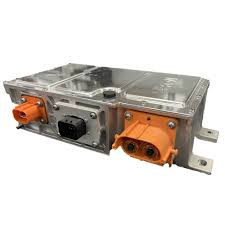views
The automotive DC-DC converters market is rapidly gaining importance in the evolving landscape of electric and hybrid vehicles. These converters are responsible for stepping down high-voltage battery power to lower voltages used by various vehicle subsystems such as lighting, infotainment, and control modules. As the automotive industry transitions toward cleaner, smarter, and more efficient mobility solutions, the demand for DC-DC converters is rising sharply. Numerous accelerators are propelling this market forward, ranging from technological innovations and supportive government policies to rising consumer demand for electric vehicles and advancements in power electronics.

Surge in Electric and Hybrid Vehicle Adoption
One of the strongest accelerators of the DC-DC converters market is the explosive growth in electric and hybrid vehicle sales worldwide. Governments and environmental agencies are aggressively pushing for reduced emissions and sustainable transport solutions. This trend has led to massive investments in electric mobility infrastructure and increased production of battery electric vehicles (BEVs), plug-in hybrids (PHEVs), and hybrid electric vehicles (HEVs).
Since these vehicles depend heavily on DC-DC converters to manage voltage transitions between high-voltage batteries and low-voltage electrical systems, their growing presence directly correlates to a surge in converter demand. As electric vehicle penetration deepens across regions, particularly in Europe, North America, and parts of Asia, the DC-DC converter market is expected to follow a steep upward trajectory.
Advancements in Power Electronics Technology
Another critical market accelerator is the advancement in semiconductor and power electronics technologies. New materials like silicon carbide (SiC) and gallium nitride (GaN) are enabling the production of smaller, more efficient, and more robust DC-DC converters. These materials offer higher switching frequencies, reduced power losses, and better thermal performance than traditional silicon-based devices.
As automotive manufacturers seek to increase vehicle efficiency and range while reducing weight and space, these next-generation converters have become essential components. Technological progress is also enabling bidirectional DC-DC converters, which are necessary for functions such as regenerative braking and energy backflow to the battery—further enhancing energy efficiency in EVs.
Government Incentives and Regulatory Push
Supportive government policies and regulations have become key accelerators for the automotive DC-DC converters market. Many national and regional authorities offer tax credits, purchase subsidies, and R&D grants for electric vehicles and green technologies. Additionally, strict emission standards and deadlines to phase out internal combustion engines (ICE) in various countries are pushing OEMs to invest more in electric and hybrid vehicle platforms.
DC-DC converters, as vital enablers of EV functionality, benefit indirectly from these policy-driven market shifts. As more automotive manufacturers comply with clean energy targets, the demand for reliable and efficient DC-DC converter solutions increases.
Integration of Advanced Vehicle Electronics
Modern vehicles are evolving into sophisticated electronic platforms, equipped with high-tech features such as autonomous driving systems, advanced driver assistance systems (ADAS), infotainment units, and telematics. These systems require consistent, regulated low-voltage power to operate effectively and safely.
DC-DC converters play a critical role in ensuring power quality and distribution across these systems. As the number of electronic control units (ECUs) in vehicles increases, so does the need for compact, reliable DC-DC converters. The trend toward vehicle electrification and digitalization is thereby accelerating converter demand in both high-end and mid-range vehicle segments.
Growing Investments by Automotive OEMs and Tier-1 Suppliers
Automotive OEMs and suppliers are ramping up investments in electric vehicle platforms and associated component technologies, including DC-DC converters. Many have formed strategic partnerships with semiconductor manufacturers or are developing in-house expertise to secure control over core vehicle electronics.
This vertical integration accelerates innovation and shortens time-to-market for new converter designs tailored to specific vehicle platforms. It also promotes standardization and cost reduction over time, making it easier to incorporate high-performance DC-DC converters across different models and brands.
Expansion of Charging Infrastructure and Vehicle-to-Grid Integration
The rapid development of charging infrastructure and the concept of vehicle-to-grid (V2G) technology are also acting as accelerators. DC-DC converters are instrumental in managing energy flow between vehicles and charging stations. In bidirectional V2G systems, these converters help return unused electricity from the vehicle battery to the grid, promoting energy efficiency and grid stability.
As countries continue to invest in EV charging networks, the need for intelligent, high-efficiency DC-DC converters will grow. These components not only facilitate faster and safer charging but also contribute to the development of smart energy ecosystems.
Consumer Awareness and Demand for Sustainable Mobility
Finally, increasing consumer awareness of sustainability and energy efficiency is pushing automakers to prioritize electric vehicles over traditional models. With EVs becoming more mainstream, consumers expect higher performance, better reliability, and enhanced range—all of which depend on optimized power management.
DC-DC converters are at the heart of these expectations. Their ability to efficiently manage electrical loads directly affects vehicle functionality and user experience. As consumers become more informed about EV technology, demand for quality and innovation in components like converters will intensify.
Conclusion
The automotive DC-DC converters market is accelerating on the back of multiple industry and consumer-driven factors. Rising electric vehicle adoption, technological advancements, government policies, and growing vehicle electrification are all acting as strong catalysts for market growth. As the automotive sector continues to transform, DC-DC converters will play an increasingly vital role in enabling next-generation mobility. Companies that can innovate and scale efficiently will be best positioned to capitalize on this fast-evolving and promising market segment.






















Comments
0 comment